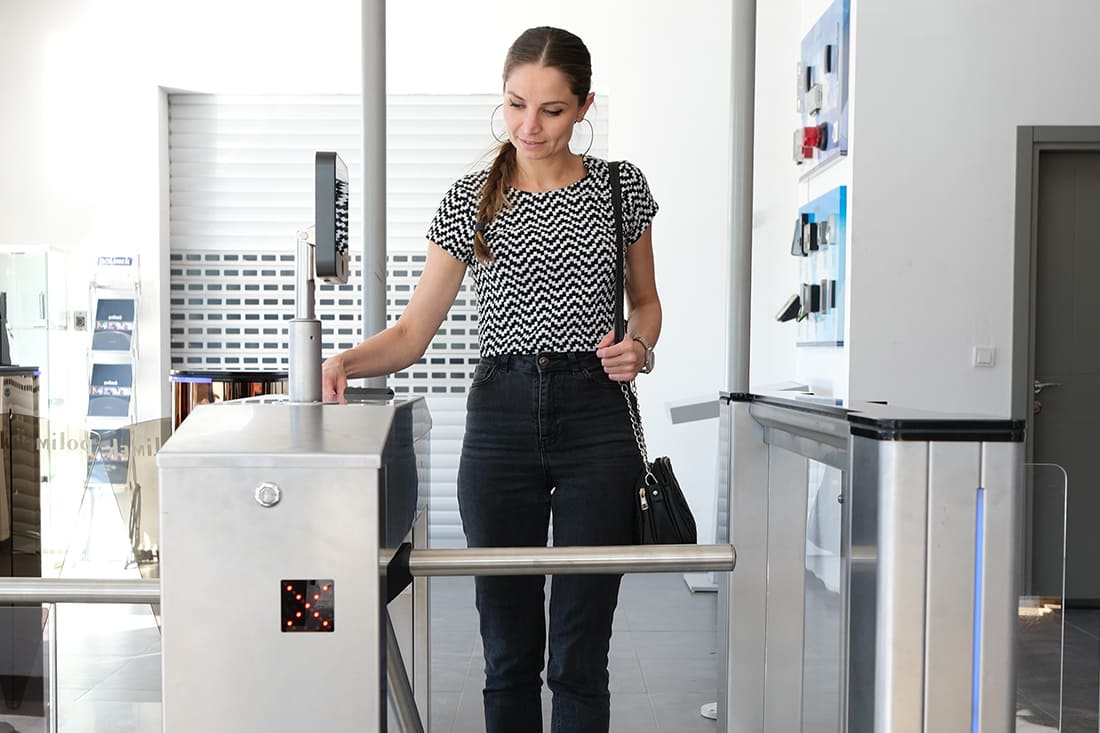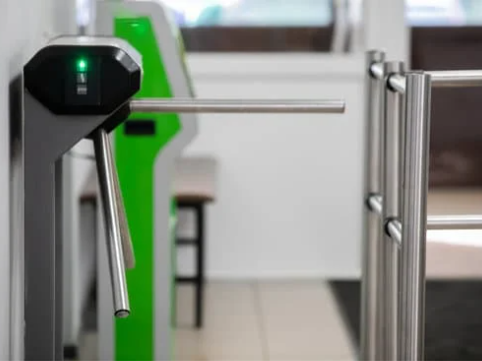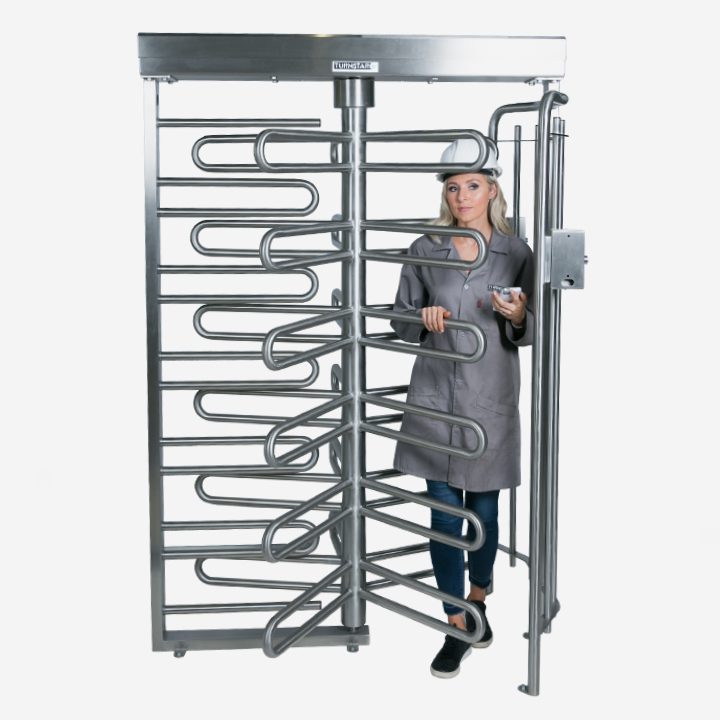- Home
- About Us
- Products
- Electronic Article Surveillance System EAS / Retail Anti theft Systems
- Display Stands
- Restaurant Pager
- People Counting Systems
- Queue Management Systems
- Access Control System
- Time Attendance Systems
- Audio & Visual System Solutions
- Display Solutions
- CCTV Cameras in Qatar: Enhancing Security Solutions
- Time Lapse Construction Camera
- Flap Barrier, Speed Gates, Turnstiles Access Control
- Gate Barriers System & Bollards in Qatar
- Parking Management & Gate Automation
- Library Management Systems
- IT & Telecom
- Lockers & Key Management Systems
- Intrusion Alarm System
- Perimeter Security
- Vehicle Tracking
- Time Recorders & Time Stamps
- Emergency Exit Door Alarms
- Clients
- Contact Us
- Support
Contents
- 1 Access Control Turnstiles in Qatar: A Comprehensive Guide
- 1.1 Introduction
- 1.2 What are Access Control Turnstiles in Qatar?
- 1.2.1 How Do Access Control Turnstiles Work?
- 1.2.2 Different Models of Access Control Turnstiles in Qatar
- 1.2.3 Benefits of Access Control Turnstiles
- 1.2.4 What are the features of access control turnstile qatar?
- 1.2.5 How do I install an access control turnstiles in Qatar?
- 1.2.6 How do I maintain an access control turnstiles in Qatar?
- 1.2.7 Which type of credentials we can use for access control turnstile in qatar?
- 1.2.8 What are the benefits of using Axle Systems?
- 1.2.9 Case Studies
- 1.2.10 Frequently Asked Questions
- 1.2.11 Conclusion
Access Control Turnstiles in Qatar: A Comprehensive Guide
Introduction
In today’s world, security is of paramount importance. One of the most effective ways to ensure this is through the use of access control turnstiles. In Qatar, these devices have become increasingly popular, thanks to their efficiency and reliability. This article will delve into what access control turnstiles are, how they work, their different models, and their benefits. We will also provide some case studies and answer some frequently asked questions.
What are Access Control Turnstiles in Qatar?
Access control turnstiles in Qatar are physical security solutions that allow or restrict access to a particular area. They are commonly used in public transport stations, stadiums, offices, and more. In Qatar, companies like Axle Systems are leading distributors of these devices, providing a wide range of models to meet different needs.
Access control turnstiles in Qatar are a crucial component in the security infrastructure of many establishments. They serve as physical barriers that regulate the flow of people into and out of a facility, allowing only authorized individuals to pass through. This is achieved by validating credentials, which could be a ticket, a card, or biometric data.
The concept of Access control turnstiles in Qatar is not new. It has been in use for centuries, with the earliest forms being simple stiles made of wood or stone. However, with advancements in technology, modern access control turnstiles have evolved into sophisticated devices that offer a high level of security and efficiency.
One of the key features of Access control turnstiles in Qatar is their ability to integrate with various types of access control systems. This includes card readers, biometric scanners, and ticketing systems. When a person presents their credentials to the reader, the system verifies the information. If the credentials are valid, the turnstile unlocks, allowing the person to pass through. Once the person has passed, the turnstile locks again, ready for the next user.
Access control turnstiles in Qatar come in various designs and sizes to cater to different needs. Some common types include tripod turnstiles, full-height turnstiles, and optical turnstiles. Tripod turnstiles are compact and suitable for areas with high pedestrian traffic. Full-height turnstiles offer a higher level of security and are often used in high-risk areas. Optical turnstiles use infrared sensors or beams to detect passage and are ideal for areas where physical barriers are not desired.
In addition to controlling access, turnstiles also provide valuable data. They can track the number of people entering or exiting a facility, the time of entry or exit, and the duration of stay. This data can be used for various purposes, such as managing occupancy levels, optimizing staffing, and improving overall operations.
Despite their many benefits, Access control turnstiles in Qatar are not without challenges. They require regular maintenance to ensure their optimal performance. This includes cleaning, lubrication, and inspection of mechanical parts. Also, while turnstiles enhance security, they should not be relied upon as the sole security measure. They should be part of a comprehensive security plan that includes surveillance cameras, security personnel, and other security measures.
How Do Access Control Turnstiles Work?
Access control turnstiles in Qatar work by validating credentials before allowing access. These credentials could be a ticket, a card, or biometric data. Once validated, the turnstile unlocks, allowing the person to pass through. After the person has passed, the turnstile locks again, ready for the next user.
Access control turnstiles in Qatar are a critical component in modern security systems, providing a physical barrier that regulates the flow of people into and out of a facility. They work on a simple yet effective principle: validate credentials before granting access. This process involves several steps and components, which we will explore in detail.
Step 1: Presenting Credentials
The first step in the operation of an Access control turnstiles in Qatar is the presentation of credentials. These credentials can take various forms, including tickets, cards, or biometric data. For instance, in a subway station, a passenger might use a ticket or a contactless card as their credential. In a high-security facility, biometric data such as fingerprints or facial recognition might be used.
Step 2: Credential Validation
Once the credential is presented, the next step is validation. This is where the access control system comes into play. The system checks the presented credential against a database of authorized credentials. This database could be stored locally or in the cloud, depending on the specific setup of the system.
Step 3: Access Granted or Denied
If the credential is found in the database and is valid, the system sends a signal to the turnstile to unlock and allow the person to pass through. If the credential is not valid or not found in the database, access is denied, and the turnstile remains locked.
Step 4: Passage and Re-locking
After the person has passed through the turnstile, it automatically locks again, ready for the next user. This ensures that only one person can pass through at a time, preventing tailgating or unauthorized access.
Additional Features
Modern Access control turnstiles in Qatar come with additional features that enhance their functionality. For instance, some turnstiles have anti-tailgating features that prevent more than one person from passing through at a time. Others have anti-passback features that prevent a credential from being used to gain access more than once within a certain period.
Integration with Other Systems
Access control turnstiles in Qatar can also be integrated with other systems for enhanced functionality. For example, they can be linked with surveillance cameras to provide visual confirmation of who is passing through the turnstile. They can also be integrated with fire alarm systems to automatically unlock in the event of an emergency, allowing for quick and safe evacuation.
Different Models of Access Control Turnstiles in Qatar
There are several models of Access control turnstiles in Qatar, each designed to suit different environments and needs. Some of the popular models include:
- Tripod Turnstiles: These are the most common type and are suitable for areas with high pedestrian traffic.
- Full-Height Turnstiles: These are often used in high-security areas as they prevent tailgating and jumping over.
- Optical Turnstiles: These use infrared sensors or beams to detect passage and are ideal for areas where physical barriers are not desired.
Benefits of Access Control Turnstiles
Access control turnstiles offer numerous benefits, including:
- Enhanced Security: They prevent unauthorized access and tailgating, thereby enhancing the security of the premises.
- Efficient Traffic Management: They efficiently manage pedestrian traffic, especially in high-traffic areas.
- Reduced Staffing Costs: They automate the access control process, reducing the need for security personnel.
What are the features of access control turnstile qatar?
Access control turnstiles in Qatar come with a variety of features designed to enhance security and efficiency. Here are some of the key features:
- Adjustable Direction: The direction of the access control turnstile gate can be adjusted according to the needs of the facility.
- Integration with Access Card Readers: These turnstiles can integrate with any brand of access card reader, providing flexibility in terms of the access control system used.
- Choice of Finishes: Turnstiles are available in a variety of finishes to match the aesthetic of the building or facility.
- Energy-Efficient Lighting: Many models feature energy-efficient LED strips that provide lighting and enhance the turnstile’s appearance.
- Durable Materials: The panels of these turnstiles are made of glass and steel, making them resistant to wear and tear, vandal-proof, and easy to clean.
- Built-In Electronics: Most of the solutions for pedestrian access control available in Qatar come with built-in electronics.
- Anti-Panic Functionality: These pedestrian gates can be integrated with an emergency alarm system to offer free passage in case of fire or any other emergency.
- Single Passage: The access turnstile and speed gates allow single passage in one side or both sides as preset by the system.
These features make access control turnstiles a versatile and effective solution for managing people flow and enhancing security in various facilities.
How do I install an access control turnstiles in Qatar?
Installing an access control turnstile involves several steps and can vary depending on the specific model and manufacturer. Here’s a general guide:
Determine the Installation Location: Decide where the turnstile will be installed.
Prepare the Ground: The turnstile cover is opened, and anchors are fixed to the ground with chemical dowels.
Place the Turnstile: The turnstile is then placed on the anchors.
Connect to Power and Network: A socket and ethernet cable are typically needed for the assembly of the turnstile system.
Install the Access Control Device: This could be a card reader, biometric scanner, ticket reader, etc., depending on your specific needs.
Test the System: Once everything is installed, test the system to ensure it’s working correctly.
How do I maintain an access control turnstiles in Qatar?
Maintaining an access control turnstile involves regular checks and cleaning to ensure its optimal performance. Here are some general steps you can follow:
- Ensure the Turnstiles Operate as Intended: Regularly test the turnstiles using the access control equipment to make sure they are functioning correctly.
- Check for Damage: Look for any obvious signs of damage to the pedestal enclosure and power supply units.
- Clean the Turnstile: Remove the pedestal side panels and inspect for the accumulation of dust and debris. Clean as required.
- Inspect the Internal Components: Check the printed circuit boards, cable assemblies, and power supplies for loose connections.
- Check the Mounting Hardware: Ensure that the pedestal mounting hardware is secure, and tighten if necessary.
- Measure the Supply Voltage: Record the supply voltage at the respective power supplies and at the CPU card.
- Test the System: Test the optical beams, lane status indicators, and CPU functionality.
- Adjust the Motor Controller: On models with barriers, measure belt tension or gear meshing. Make adjustments as required so tolerances are within specification.
Remember, these are general guidelines and the exact maintenance procedures can vary depending on the specific model and manufacturer of your turnstile. Always refer to the manufacturer’s instructions or hire a professional for maintenance to ensure safety and functionality.
Which type of credentials we can use for access control turnstile in qatar?
Access control turnstiles in Qatar can use a variety of credentials for authentication. Here are some commonly used types:
- Smart Cards: These are often used with turnstiles and can be of the RFID type1. The user presents the card to a reader integrated with the turnstile to gain access.
- Biometric Data: Biometric readers can be installed with turnstiles for higher security. This could include fingerprint scanning, facial recognition, or iris scanning. The user’s biometric data is compared to a stored profile to verify their identity.
- Proximity Cards: These work similarly to smart cards but use radio frequency identification (RFID) technology. The user doesn’t need to physically touch the card to the reader; they just need to be in close proximity.
- Tickets: For temporary access or in places like public transport stations, tickets with barcodes or magnetic stripes can be used.
What are the benefits of using Axle Systems?
Axle Systems is a leading provider of security solutions, including Access control turnstiles in Qatar. While I couldn’t find specific benefits of using Axle Systems, companies like Axle Systems generally offer several advantages:
- Wide Range of Products: They provide a wide range of security solutions, allowing you to choose the one that best fits your needs.
- Quality and Reliability: Their products are known for their quality and reliability, ensuring that your security system performs optimally at all times.
- Customer Support: They often provide excellent customer support, helping you choose the right product, install it, and maintain it.
- Experience and Expertise: Companies like Axle Systems have years of experience and expertise in the field of security solutions, ensuring that you get the best products and services.
For more specific benefits of using Axle Systems, I recommend reaching out to them directly or visit ther website. Let me know if you need help with anything else.
Case Studies
- Case Study 1: A large corporation in Doha installed full-height turnstiles at their headquarters. This significantly reduced unauthorized access and improved overall security.
- Case Study 2: A popular stadium in Qatar implemented tripod turnstiles at their entrances. This streamlined the entry process during events, improving customer satisfaction.
Frequently Asked Questions
- Q: How do I choose the right Access control turnstiles in Qatar? A: Consider factors such as the level of security needed, the volume of traffic, and the available space.
- Q: How do I maintain my Access control turnstiles in Qatar? A: Regular maintenance involves cleaning, lubrication, and inspection of mechanical parts.
- What are access control turnstiles? Access control turnstiles in Qatar are physical security solutions that allow or restrict access to a particular area.
- How do access control turnstiles work? They work by validating credentials before allowing access. These credentials could be a ticket, a card, or biometric data.
- What types of Access control turnstiles in Qatar? There are several models available, including tripod turnstiles, full-height turnstiles, and optical turnstiles.
- What are the benefits of using Access control turnstiles in Qatar? They enhance security, manage pedestrian traffic efficiently, and reduce staffing costs.
- How do I install an access control turnstile? Installation involves determining the location, preparing the ground, placing the turnstile, connecting to power and network, installing the access control device, and testing the system.
- How do I maintain an Access control turnstiles in Qatar? Maintenance involves regular checks and cleaning, checking for damage, cleaning the turnstile, inspecting the internal components, checking the mounting hardware, measuring the supply voltage, testing the system, and adjusting the motor controller.
- Which type of credentials can be used for access control turnstiles in Qatar? Credentials can include smart cards, biometric data, proximity cards, and tickets.
- What are the features of access control turnstiles in Qatar? Features can include adjustable direction, integration with access card readers, choice of finishes, energy-efficient lighting, durable materials, built-in electronics, anti-panic functionality, and single passage.
Conclusion
In conclusion, Access control turnstiles in Qatar have emerged as a powerful tool in the realm of security and pedestrian traffic management. Their ability to control access to a particular area based on validated credentials makes them an indispensable asset for many establishments. They not only enhance security but also streamline the flow of people, making them ideal for places with high pedestrian traffic.
In Qatar, one of the trusted distributors of these devices is Axle Systems. With their wide range of products and commitment to quality, Axle Systems has established itself as a reliable provider of access control turnstiles. They offer various models, each designed to cater to different needs and environments. Whether it’s a high-security area requiring full-height turnstiles or a public transport station needing tripod turnstiles, Axle Systems has got it covered.
Moreover, Axle Systems provides excellent customer support, assisting clients in choosing the right product, installing it, and maintaining it. Their expertise and experience in the field ensure that clients get the best products and services.
So, if you’re in Qatar and looking for the perfect Access control turnstiles in Qatar for your needs, don’t hesitate to contact Axle Systems. Their team of experts will guide you through the process, ensuring that you get a solution that best fits your requirements. Remember, a well-implemented access control turnstile can significantly enhance the security and efficiency of your establishment. So, make the smart choice today with Axle Systems. Let them help you create a safer and more efficient space.





